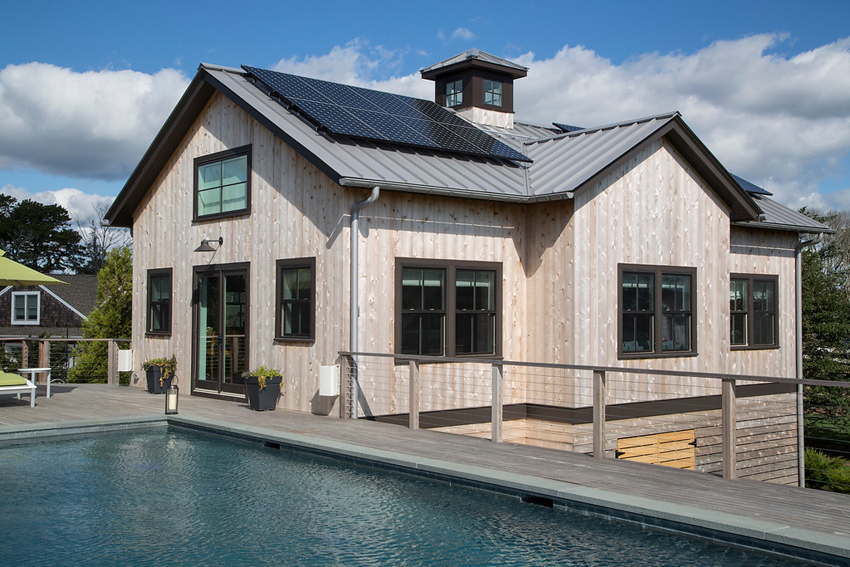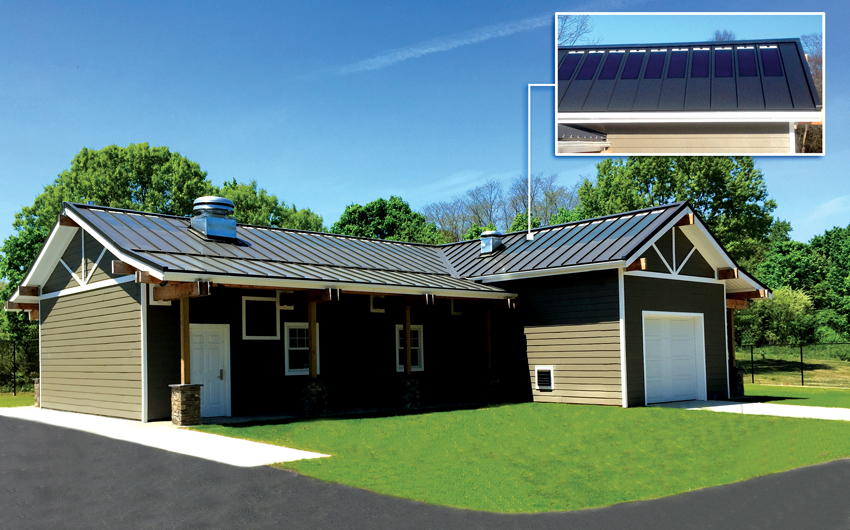Innovative Technologies for Sustainable Building Envelopes
Solar-Ready Roofing
Metal roofs are an excellent platform for photovoltaic (PV) systems. They offer recyclability, strength, and weather resistance, as well as a longer service life compared to other roofing materials. In the Metal Construction Association’s white paper “Benefits of Retrofit Roofing,” research from the Metal Advisory Group reported that mounting a PV system on a sloped metal roof can provide energy savings of 24–43 percent over a conventional roof.7

A solar-ready, standing-seam cool metal roof is an ideal platform for solar panels.
To promote energy independence and the reduction of carbon dioxide emissions, federal, state, and utility incentives may be available for the installation and operation of photovoltaic systems.
PV systems work with net metering that tracks both the electricity consumed on-site and the electricity generated by the PV system. The energy collected by the solar panels is channeled to an inverter that changes the DC electricity to AC electricity for building use. AC electricity that is not immediately used by the building can be directed into the local grid. This may result in a credit from the utility company, causing the meter to spin backward. When electricity is required, it is drawn from the power company grid, and the meter spins forward.
There are two basic types of photovoltaics: crystalline and building integrated photovoltaic (BIPV).
Crystalline Solar Panels
The major share of the market is made up of crystalline modules. They are the types of panels that you typically see on rooftops or ground-mounted in fields.
Crystalline panels offer the highest efficiency for converting sunlight into electricity. They can be attached onto standing-seam metal roof panels with easy-to-install clips. No penetrations are needed for attachment; therefore, there are no issues with water infiltration, plus the roof warranty remains intact.
Conversely, conventional membrane or ballasted roofs often use racking for PV systems. In many cases, the racks need to be secured into the structural system of the roof. This requires penetrations through the roof, which can be potential areas for leaks. The main issue, however, is that the PV service life is more than that of the various conventional roof membranes. As a result, when the roof has to be replaced, decommissioning the solar system may dramatically increase costs of the roof replacement.
Building Integrated Photovoltaic (BIPV)
BIPV systems (also referred to as thin-film laminates) are complete, pre-engineered, and standardized solar roof systems.

Thin-film photovoltaic laminates integrate with the flat pans between the standing seams of the roof.
The film is a stainless steel substrate with an ethylene tetrafluoroethylene (ETFE) protective coating. Amorphous silicon and copper indium/gallium diselenide (CIGS) technologies are used in BIPV products.
BIPVs are lightweight, flexible (which permits curving), and durable, plus they help to maintain the serviceability of the roof. Typically, they are warranted for 25 years.
From an aesthetic perspective, BIPV products are appealing because they integrate nicely with the flat pans between the standing seams of the roof. BIPV systems are used anywhere that standing-seam roofs are specified.
Crystalline Systems versus BIPV Systems
Although crystalline systems produce at a higher efficiency during midday, BIPV systems are better able to produce energy in diffuse, low light. As a result, they can pick up three spectrums of light, whereas crystalline systems only pick up one. This also means BIPV systems produce energy earlier in the day and end production later in the day.
However, BIPV laminates are separated by the seams of a standing-seam roof. Therefore, they require roughly twice the square footage of available rooftop space to design the same size system as crystalline panels.
All of this means that it is difficult to make apples-to-apples comparisons. The best approach is to explore the options on a case-by-case basis centered on project criteria.
LEED v4: Potential Contribution of Photovoltaics
- Integrative Process (1 point)
- Minimum Energy Performance (prerequisite)
- Optimize Energy Performance (up to 18 points)
- Renewable Energy Production (up to 3 points)
- Innovation (up to 5 points)
Conclusion
Working with the forces of nature, designing semi-passive systems of stunning simplicity is perhaps the most cost-effective and operationally prudent path to sustainability. Energy is saved, carbon emissions are reduced, and operating and maintenance costs are almost nil.
Transpired solar collectors are a cost-effective means to improve ventilation and indoor air quality while reducing energy consumption and achieving sustainable building design objectives. Cool roofing is gaining in popularity because it can help reduce peak cooling energy demands in buildings and mitigate the urban heat island effect. Above-sheathing ventilation minimizes the effect of condensation between the roof layers and creates energy savings by reducing air-conditioning costs in the summer and adding insulation value during the winter. Metal roofs are an excellent platform for photovoltaic (PV) systems, as they offer recyclability, strength, and weather resistance, as well as a longer service life compared to other materials.
Due to the availability of recycled and recyclable metal components, as well as their innate longevity, the savvy designer, engineer, contractor, and building facilities manager will consider these innovative yet straightforward building envelope systems for their projects.
Kathy Price-Robinson has written about building design and construction for her entire career. www.linkedin.com/in/kathypricerobinson
END NOTES
1,2“Transpired Collectors (Solar Preheaters for Outdoor Ventilation Air).” Federal Technology Alert. National Renewable Energy Laboratory. U.S. Department of Energy. April 1998. Web. 9 April 2020.
3Renewable Energy Tax Credits. ENERGY STAR. U.S. Department of Energy. Web. 7 April 2020.
4Roberts Jr., Glenn. “Can’t Take the Heat? Cool Walls Can Reduce Energy Costs, Pollution.” Lawrence Berkeley National Laboratory. 9 July 2019. Web. 7 April 2020.
5Rosado, Pablo J. and Levinson, Ronnen. “Potential benefits of cool walls on residential and commercial buildings across California and the United States: Conserving energy, saving money, and reducing emission of greenhouse gases and air pollutants.” Energy and Buildings. 15 September 2019. Web. 7 April 2020.
6Miller, William; Desjariais, Andre; and Kosny, Jan. “A Compilation of Home Energy Assessments for Cool Roofs, Above-Sheathing Ventilation, Radiant Barriers, and Other Attic Strategies.” Thermal Performance of the Exterior Envelopes of Whole Buildings, 11th International Conference. January 2010. Web. 7 April 2020.
7“Retrofit Roofs Offer Design, Environmental, and Financial Benefits in New and Existing Construction.” Metal Construction Association. August 2016. Web. 7 April 2020.









